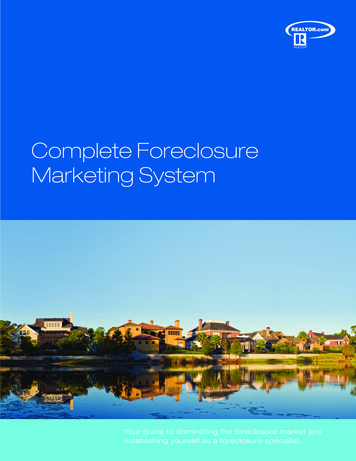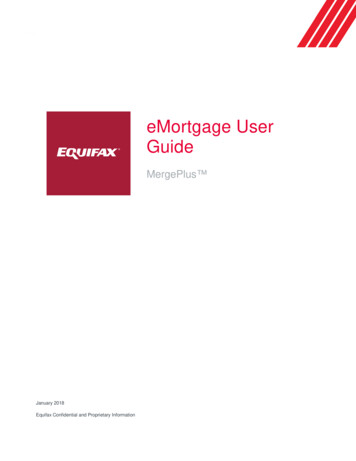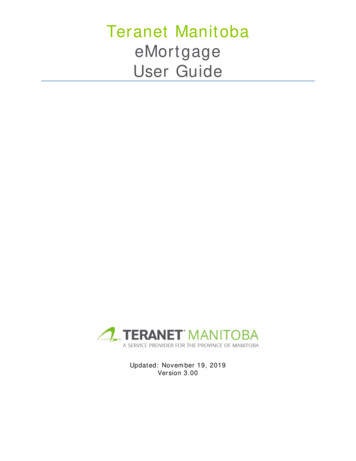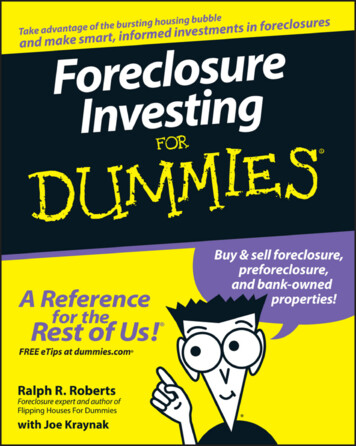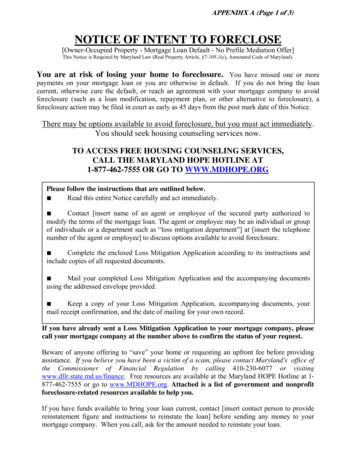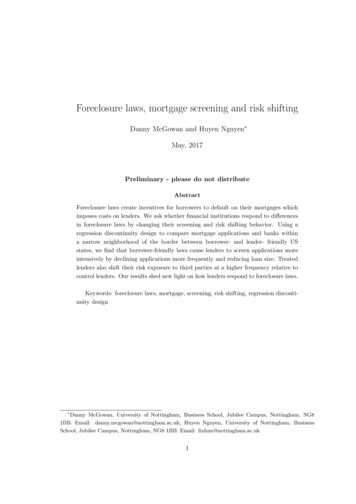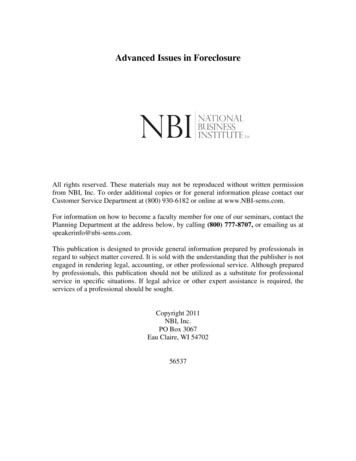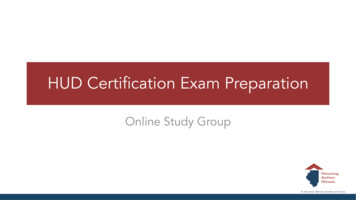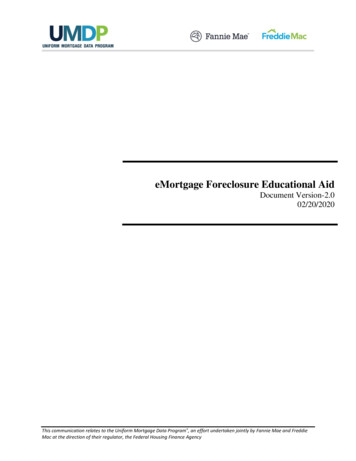
Transcription
eMortgage Foreclosure Educational AidDocument Version-2.002/20/2020This communication relates to the Uniform Mortgage Data Program , an effort undertaken jointly by Fannie Mae and FreddieMac at the direction of their regulator, the Federal Housing Finance Agency
Table of ContentsI.Introduction. 3II.Applicable Laws . 3III. Key Terms . 4IV. eNotes in the GSE Environment . 4V.Enforcement of eNotes . 5VI. Court Decisions . 6VII. GSE Resources . 7EXHIBIT A . 8Page 2 of 9
I.IntroductionThis educational aid resource, created by Fannie Mae and Freddie Mac (the “GSEs”), isintended to address a barrier to eMortgage adoption identified in the 2016 joint GSE eMortgageoutreach survey. From the survey we learned that Servicers (and some of their local foreclosurelaw firms) wanted to better understand eMortgages, specifically, how eMortgages areforeclosed. While this document does discuss the Electronic Signatures in Global and NationalCommerce Act, 15 U.S.C. §7001, et seq. (“ESIGN”) and its interaction with the model UniformElectronic Transactions Act (“UETA”), the GSEs do not intend nor should anyone construe,the information herein to be legal advice upon or an interpretation of any state’s adoptedversion of the UETA.This document provides a high level summary of the federal law, ESIGN, and how it governseNotes and eMortgages and a basic overview on foreclosure of eMortgages. II.An overview of transferable records (eNotes)Definitions for key terms related to eMortgagesImportant eMortgage foreclosure court decisionsOther important information on the eMortgage foreclosure processApplicable LawsThe essential difference between a transferable record (eNote) and a traditional paper Note isthat an eNote does not exist in physical form. Therefore, the common test for standing inforeclosure cases (the foreclosing party should (or must) be the “holder” of the Note bypossessing a paper Note indorsed in blank or indorsed to the foreclosing party) doesn’t workwith eNotes since there is no instrument to possess. The applicable laws that govern electronictransactions are: In 2000, Congress passed ESIGN. The ESIGN states that contracts and signatures may notbe deemed invalid simply because they are in electronic form. ESIGN further provides thatelectronic contracts and other records can be retained in electronic form as long as 1) theyaccurately reflect the information set forth in the contract or record, 2) are accessible to theparties and 3) can be accurately reproduced by electronic transmission or printing on paper. In 1999, the UETA was drafted by the Uniform Law Commission. It has been adopted in 47States and the District of Columbia (but not Illinois, New York or Washington at this time).ESIGN and the UETA essentially parallel each other, legitimizing electronic recordsthroughout the country. The text is available ic%20transactions/ueta final 99.pdf.11Despite its name, UETA has not been adopted uniformly across the U.S. - California, for instance, omitssections 16-20 of UETA (Cal. Civ. Code §§ 1633.1 – 1633.17). Accordingly, it is the GSEs’ view thatESIGN supersedes the California UETA, at least for transferable records (eNotes).Page 3 of 9
III.Key TermsIt’s important to understand some of the key terms used in connection with eMortgage, whichare defined below: Transferable Record: Both ESIGN and UETA contain special sections for “transferablerecords” (ESIGN 15 U.S.C. §7021; UETA §16). A “transferable record” is an electronicrecord that would be a Note under Article 3 of the Uniform Commercial Code (UCC) if itwere in writing. To be a transferable record, the issuer (borrower) must have agreed thedocument is a transferable record and the document must relate to a loan secured byreal property. (GSEs often refer to transferable records as “eNotes”). Control: ESIGN and UETA then provide that a “person having control” (in the MERS eRegistry, this person is referred to as the “Controller”) of a transferable record is theequivalent of a “holder”, as that term is used in the State’s version of the UCC, and hasthe same rights and defenses as a “holder”. A “person has control” of a transferablerecord if the system employed for evidencing the transfer of interests in the transferablerecord reliably establishes that person as the person to which the transferable recordwas issued or transferred. (ESIGN 15 U.S.C. §7021 (b); UETA §16b). The mostcommon system for evidencing the transfer of interests in eNotes is the eRegistryoperated by MERS . (The MERS eRegistry tracks the identity of the person thathas Control and refers to that person as the “Controller” of the eNote). Authoritative Copy: A system satisfies the conditions of ESIGN and UETA if it maintainsrecords in a manner such that an “Authoritative Copy” of the transferable record exists.An authoritative copy must be a single, unique, identifiable, and generally unalterablecopy. (This means that while there can be many copies of each eNote, there can beonly one authoritative copy of the eNote, and only the Controller of theauthoritative copy can enforce it.) Location: The MERS eRegistry tracks the “Location” of every eNote. In the MERS eRegistry, the location is a named party (usually the Controller or its designee) thatstores the eNote in an eNote Vault, similar to a document custodian storing an originalpaper Note.The interplay of Controller, Location, and Authoritative Copy is discussed in the GSE context,below.IV.eNotes in the GSE EnvironmentThe information below provides an overview of the delivery of eNotes to the GSEs. Thisinformation is particularly relevant for understanding the requirement for a transfer of control inorder to enforce an eNote.There are two components of the process that warrant explanation. The MERS eRegistry – the system of record identifying the Controller and the location ofthe eNote. The MERS eRegistry allows eNotes to be registered and tracked to the single,unique authoritative copy of the transferable record (eNote).Page 4 of 9
GSE eNote Vault – refers to the GSEs’ respective electronic storage systems that eNotesare delivered to and stored in.An overview of the eNote delivery process is as follows: The eNote is electronically signed by the borrower through use of an electronic closingsystem (“eClosing System”). The eClosing System secures the electronically signed documents by applying atamper-evident seal to the entire transferable record (eNote). The eNote must be registered on the MERS eRegistry within one business day. The lender transmits the eNote to the applicable GSE eNote Vault using the MERS eDelivery software application.The lender submits a request to the MERS eRegistry to transfer control of the eNotefrom the lender to the applicable GSE. The GSE eNote Vault validates that the tamper-evident seal value on each eNotedelivered by lender and matches the tamper-evident seal value stored in the MERS eRegistry and, if the values match, accepts the eNote delivery.So, for all eNotes purchased by the GSEs, the applicable GSE becomes the Controller and theAuthoritative Copy of the transferable record (eNote) is stored in the applicable GSE’s eNoteVault.V.Enforcement of eNoteThe requirements for paper Notes and eNotes are the same as it relates to the following: Pre-enforcement workout solicitation requirements.Notices and GSE workout requirements.GSE requirements for the selection of foreclosure counsel.However, some aspects of the enforcement process are quite different for eNotes. The partyseeking to enforce a transferable record (eNote) must have Control of the transferable record(eNote). The Controller of a transferable record (eNote) has the same rights as the Holder of apaper note under the UCC. Since the GSEs are identified as the Controller of the transferablerecord (eNote) in the MERS eRegistry, when foreclosure is the action that must be taken, inmany jurisdictions control of the authoritative copy of the transferable record (eNote) will need tobe transferred from the applicable GSE to the Servicer for the Servicer to enforce the Note in itsname.2 The process for requesting transfer of control from the GSEs are provided below: For Fannie Mae loans: A transfer of control can be initiated by contacting Fannie Mae’sCustodian Oversight Department at eMortgage Custody@FannieMae.com andThe discussion in the main text concerns handling of the eNote. Don’t forget that for loans registered inthe MERS System, the security instrument must also be assigned from MERS to the foreclosing party(usually the servicer) before starting the foreclosure.2Page 5 of 9
submitting Form 2009, Request for Release/Return of Documents. Note that at present,when Control is transferred on a Fannie Mae eNote, the location of the eNote in theMERS eRegistry is simultaneously transferred as well from the Fannie Mae eNote Vaultto the servicer’s eNote Vault. Although transfer of the eNote’s location is not legallyrequired in order to enforce the eNote, at present Fannie Mae requires that both controland location transfer to the Servicer at time of enforcement. When Fannie Mae systemupgrades are completed in late 2017, Servicers will be able to transfer control of theeNote without changing the location of the eNote. For Freddie Mac loans: The Servicer desiring the transfer of control and/or locationshould submit the request to Loan Delivery Funding Ops@FreddieMac.com, threebusiness days before the change is desired. Freddie Mac will transfer control of theeNote without changing the location of the eNote, the Freddie Mac’s eNote Vault.Freddie Mac will transfer location if Servicer’s counsel determines it is necessary underapplicable state law.Regardless of the GSE, in states which require the foreclosing party to present a physical Note,the Servicer may (depending on State law requirements) print out a Servicer certified copy ofthe transferable record (eNote) and complete and execute an affidavit comparable to the GSEuniform sample Electronic Note Affidavit attached hereto as Exhibit A. Please note that thisElectronic Note Affidavit is not a substitute for, or an alternative to, an eNote. The sampleaffidavit form is suggested for use by servicers as part of enforcing the eNote and securityinstrument if a judge or Commissioner of Accounts, etc. asks for such a document or needsassistance in understanding the process of creating and storing the eNote in accordance withUETA, E-SIGN, etc.In the event the transferable record (eNote) is removed from the foreclosure process because ofreinstatement or loan modification, the Servicer must initiate a timely transfer of control (andlocation, as applicable) of the transferable record (eNote) back to the applicable GSE.The standard affidavit used today to prove up the amount of the default, could be used intandem with the Electronic Note Affidavit.Note: Be sure to use the correct ESIGN and UETA terminology in pleadings, etc. and, subject tostate law, remove references to “holder” of the Note or “possession” of the Note.VI.Court DecisionsHere are some court decisions addressing eNote foreclosures: Good v. Wells Fargo, 18 N.E.3d 618 (Ind. App. 2014): The Indiana Appellate Courtreversed an entry of summary judgment in favor of the lender, holding that the lenderfailed to adequately establish standing to foreclose. New York Community Bank v. McClendon, 29 N.Y.S.3d 507 (NY App. Div. 4/13/16): TheNew York Appellate Division reversed a decision dismissing a foreclosure complaint forlack of standing, finding that the lender adequately established standing.Page 6 of 9
Rivera v. Wells Fargo, 189 So.3d 323 (Florida 4th DCA 4/20/16): The Florida AppellateCourt upheld a decision of the trial court in favor of the lender, finding the affidavitssubmitted by the lender sufficient to establish the lender’s standing and right toforeclose. Wells Fargo v. Benitez, 2016 N.Y. Misc. LEXIS 4823 (N.Y. Supreme Court, SuffolkCounty, 12/14/2016): The New York Supreme Court (trial level) found that the lenderfailed to establish its standing as the controller or holder of the eNote .VII. GSE Resources Fannie Mae's Guide to Delivering y requirements/emortgage-delivery-guide.pdfComplete requirements for servicing eMortgage are available in Fannie Mae’s master uide/servicing/index.html Freddie Mac eMortgage Guide (Chapter 3 addresses servicing, and the sub-chapter 3.5 addressesservicing of non-performing Mortgage Guide.pdfFor additional assistance and other resources, contact the Fannie Mae legal team atdefault attorney@FannieMae.com or the Freddie Mac legal team atLegal eMortgage@FreddieMac.com.Page 7 of 9
EXHIBIT AFile No. / BORROWER NAMEELECTRONIC NOTE AFFIDAVITThe undersigned being first duly sworn, and under penalty of perjury, states as follows:1. My name is [duly authorized employee of Controller name] and I am a [title] of [legalname of Controller];2. Capitalized words used herein that are not defined, proper names, commonly capitalizedor statutory citations herein, shall have the meanings ascribed to such words in 15 U.S.C.§ 7021 and [Insert applicable State UETA statutory citation];3. The borrower(s), using an Electronic Signature, executed an electronically createdpromissory note (the “Note”) dated [date of Note], to [Enter original lender legal name].The Note represents a promise from the borrower(s) to pay [amount]. A copy of theNote is attached hereto as Exhibit A and is incorporated herein by reference;4. As part of the terms of the Note, the borrower(s) expressly agreed that the Note wouldbe:a. authenticated (signed), stored and transmitted by electronic means and that theMERS eRegistry would identify the Person in control of the Note (the“Controller”); andb. a Transferable Record pursuant to 15 U.S.C. § 7021 and [Insert applicable StateUETA statutory citation];5. On [date registered with MERS eRegistry], the Note (Transferable Record) wasregistered with the MERS eRegistry by [registering lender legal name] under MERS Organizational Identification Number [number]. The copy of the MERS eRegistryTransaction History, attached hereto as Exhibit B and incorporated herein by thisreference, identifies [legal name of controller] as the Controller of the Note (TransferableRecord);6. The Controller of the Note (Transferable Record), pursuant to 15 U.S.C. § 7021 and[Insert applicable State UETA statutory citation]:a. has the same rights as a “holder” defined in [Insert applicable State UETAstatutory citation]; andb. is the only Person who can transfer control of the Note (Transferable Record);Page 8 of 9
7. [legal name of controller], as the Controller, has not:a. conveyed, assigned, pledged, hypothecated, or encumbered the Note(Transferable Record) or;b. transferred control of the Note (Transferable Record) to any other Person; and8. The Note (Transferable Record) is secured by a Security Instrument in the originalamount of [amount] dated [date of MTG], made by [borrower’s name(s)], to [Enteroriginal lender legal name], Lender, and recorded in the Clerk's Office of the Circuit Courtof the [city/county], [State] in [recording information].[legal name of controller]By: [duly authorized representative’s signature]Name: [duly authorized representative’s typed name]Title: [title]State of ))County of )Acknowledged before me thisday of20 , by[duly authorized employee of Controller name], [title] of [legal name of Controller], a [insert typeof entity: corporation, bank, savings bank, savings & loan, credit union, limited liability company,partnership, etc.], on behalf of the Controller.Notary PublicName(SEAL)My Commission Expires:Page 9 of 9
Custodian Oversight Department at eMortgage_Custody@FannieMae.com and 2 The discussion in the main text concerns handling of the eNote. Don't forget that for loans registered in the MERS System, the security instrument must also be assigned from MERS to the foreclosing party (usually the servicer) before starting the foreclosure.
